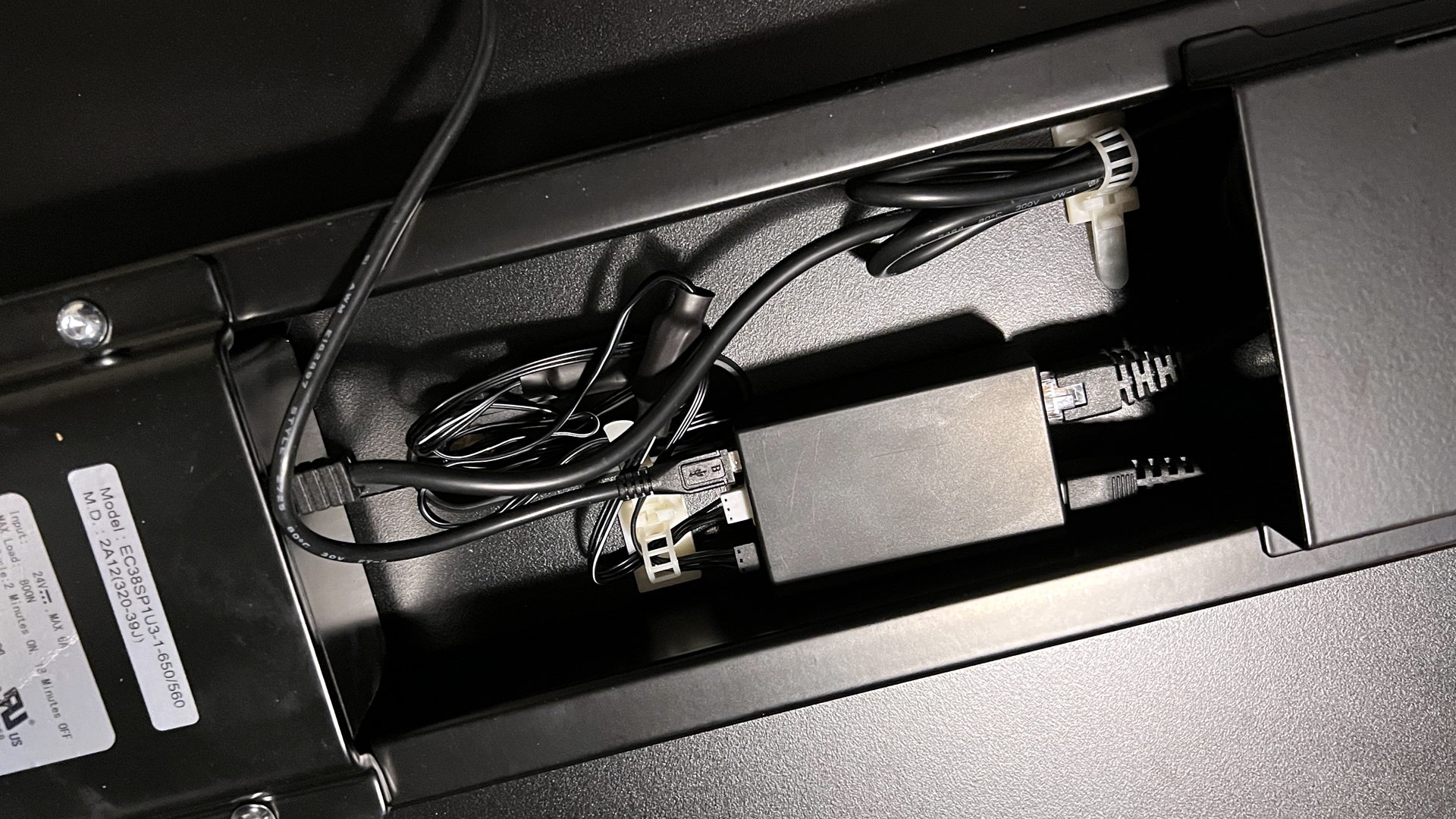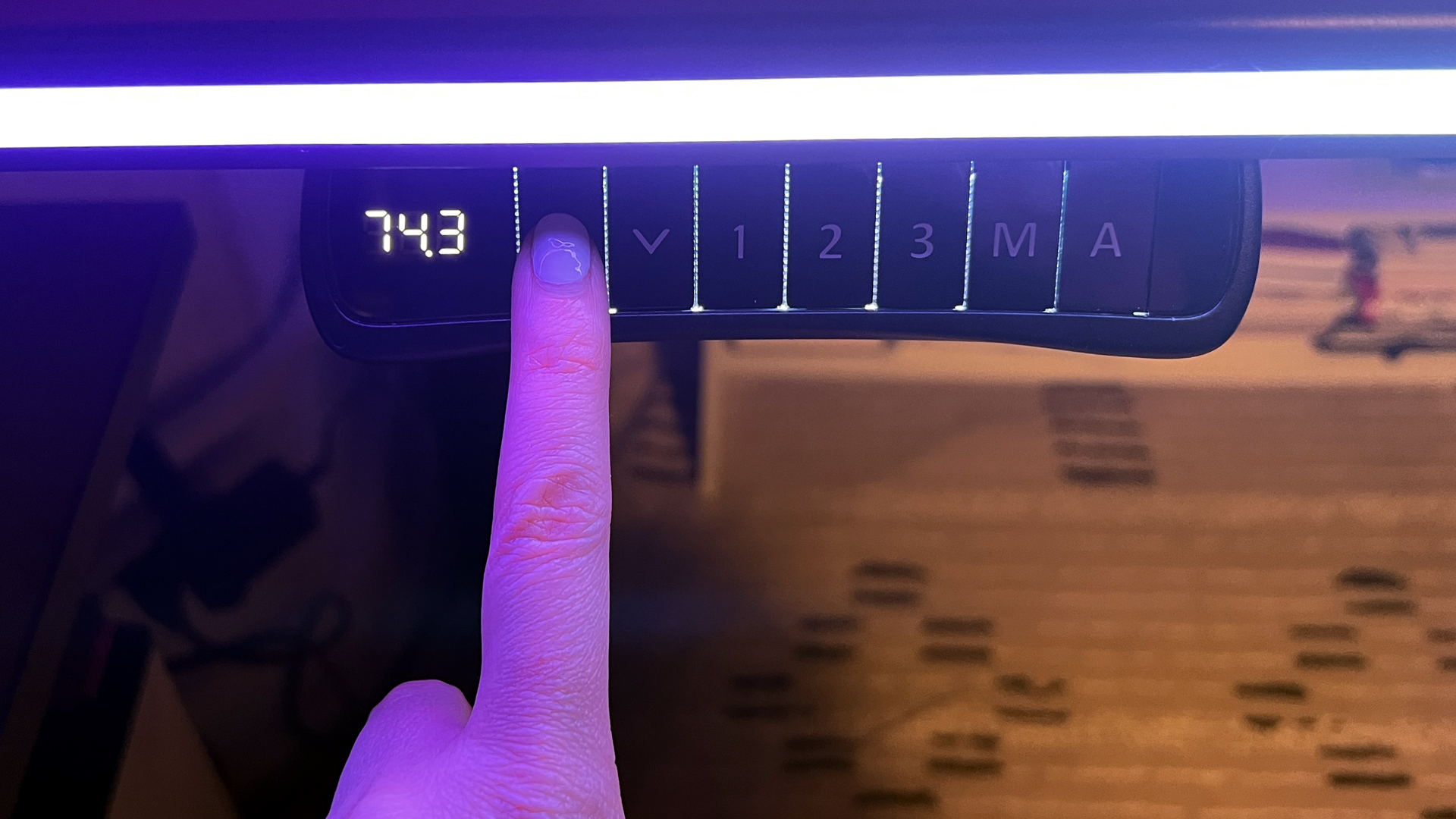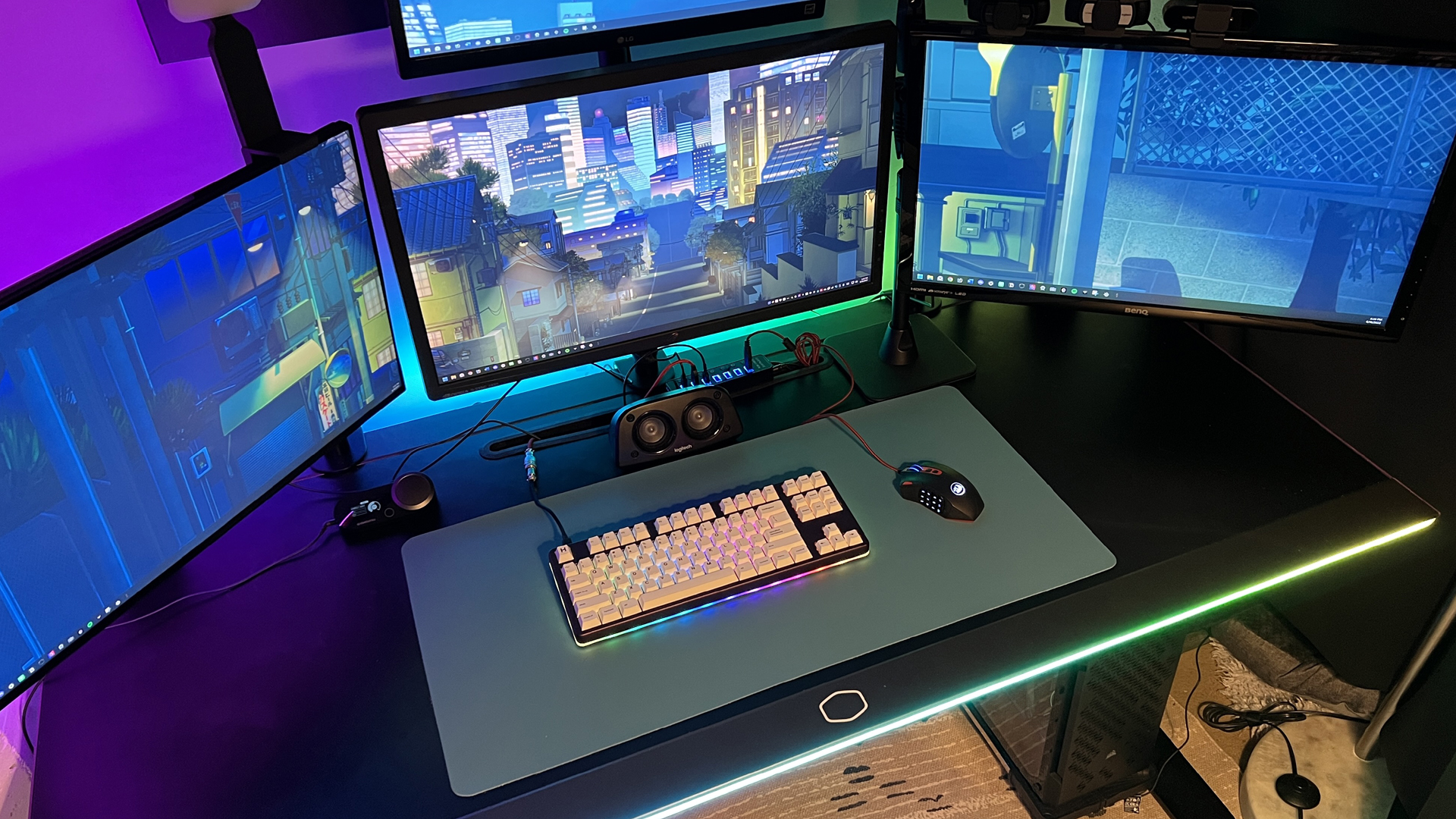Tom's Hardware Verdict
The GD160 ARGB is an electric height-adjustable gaming desk with a relatively wide height range, dual motors, a smart remote, and onboard memory. But its premium price tag is probably only worth it if you’re wooed by the desk’s bright ARGB lightstrips.
Pros
- +
Bright, attractive ARGB lighting, perfectly designed for ambient lighting
- +
Electric, height-adjustable desk with smooth, quiet motor
- +
25.6 - 51.2 inch height range
- +
Onboard memory does not need software
Cons
- -
Cable management is so-so
- -
MasterPlus+ software is clunky and limited
- -
Collision detection only works for direct collisions
Why you can trust Tom's Hardware
You’ve built the perfect rig, complete with a tactile, clicky keyboard, an ultra-light gaming mouse, an audiophile-worthy headset — maybe you’ve even invested in the perfect gaming chair. Now what?
Oh, right — something to put it on. If your desk is an afterthought — maybe something you picked up from Ikea for $40, I don’t blame you. Furniture is a pretty daunting, expensive upgrade and it doesn’t seem as important as, say, getting one of the best graphics cards. However, I speak from experience when I say that Ikea table tops (or other cheap tables) are definitely not designed to withstand the weight of multi-monitor clamp mounts.
If your gaming rig is important, it seems like your desk — which will hold everything from monitors and peripherals to the rig itself — is also pretty important. Plus, if you’re already on board the RGB train, you might as well keep going until you’ve hit full-circle — that’s what Cooler Master thinks, anyway. The company debuted its first line of gaming desks over the summer, packed with gamer-oriented features such as...a lot of ARGB.
The Cooler Master GD160 ARGB is an electric height-adjustable gaming desk that takes your gaming setup from seated to standing (and back) in seconds. It features a steel frame, dual motors, built-in collision detection, a smart controller with three programmable height presets, and bright, colorful ARGB lighting along both the front and back. ARGB lighting — with 192 individual zones — doesn’t come cheap, nor does electric height-adjustability. With a retail price of $899, the GD160 ARGB is more expensive than both Ikea and many electric standing desks. But the ARGB just might be worth it.
Specifications
| Desktop Size | 63 x 29.5 inches / 160 x 75 cm |
| Height | 25.6 - 51.2 inches / 63 - 130 cm |
| Weight | 141 pounds |
| Max Load | 220.5 pounds / 100kg |
| Materials | Chipboard, Aluminum, Steel |
| Cable Management | Tray |
| Lighting | ARGB (front/back, 96 zones each) |
| Software | MasterPlus+ |
| Accessories | Mouse pad (35.4 x 11.8 inches / 90 x 30 cm) |
| Warranty | 2 years |
Assembling the GD160 ARGB
The GD160 ARGB ships in two boxes, which weigh roughly 150 pounds combined. Both boxes contain a copy of the desk’s assembly instructions, so you can open them in either order; one box holds the tabletop, while the other contains the legs/motor, hardware, and accessories.
The desk comes with everything you need to put it together: hardware, tools (a hex wrench and a #2 Phillips screwdriver; though I used my own), and cables and cable ties for management. It also comes with a large black cloth mouse pad, which measures 35.4 x 11.8 inches (90 x 30 cm) and sports Cooler Master’s hexagon logo in purple in one corner.
The GD160 ARGB isn’t particularly difficult to put together, though it does have quite a few parts. The assembly instructions are illustrated and are relatively easy to follow, though some of the illustrations are very detailed (and small). Cooler Master also has a video installation guide, which is helpful for double-checking details.
Get Tom's Hardware's best news and in-depth reviews, straight to your inbox.
I assembled the desk by myself in a little over two hours. This included the time it took me to lift and position the desk, which was somewhat tricky given its size and weight. You probably don’t need a partner for assembly, but because it is large and sort of unwieldy, I suggest grabbing someone to help move the final product into place.
The desk will need access to one ungrounded electrical outlet for operation, and will also need to plug into your PC (via USB-A port) if you want to be able to configure the desk’s ARGB lighting using Cooler Master’s MasterPlus+ software. This is optional — you do not need to plug the desk into your PC for normal operation, which includes raising/lowering the tabletop, programming/using the three saved height buttons, or cycling through the desk’s preset ARGB lighting effects.
As far as space goes, the desk doesn’t occupy any more horizontal space than the width/depth of its tabletop. You will want to make sure there’s enough vertical clearance, however, so you can raise and lower the desk without hitting anything (e.g. electrical outlets, shelves, other desks, etc).
Design and Construction of the GD160 ARGB
The GD160 ARGB is a large, sturdy, ARGB-equipped gaming desk with a tabletop that measures 63 inches wide by 29.5 inches deep (160 x 75 cm). It’s height-adjustable, with dual electric motors and a three-stage steel frame, and has bright ARGB lighting along the front and back.
The GD160 ARGB is made of chipboard, aluminum, and steel — the tabletop is chipboard; the legs, frame, and trim are aluminum and steel. The desk has a 1-inch-thick black tabletop, which has a lightly-textured laminate finish that’s both fingerprint- and scratch-resistant. The tabletop’s sides are edged in painted steel trim (Cooler Master’s signature purple), and the front and back edges feature a 2.75-inch-thick, slightly-raised gunmetal gray lip. Cooler Master’s understated hexagon logo is printed on the front lip in matte white.
The desk has two bright ARGB lightstrips along its front and back edge, each with 96 individual zones. The front edge is angled downward, so you aren’t blinded by light when you sit at the desk, while the back edge is angled upward — maximizing the desk’s immersive lighting by reflecting off of a back wall. ARGB in a desk might sound unnecessary and gimmicky, but it actually makes for perfect ambient lighting in a home gaming setup (and perfect immersive lighting if you decide to configure the lighting to work with games or other components). The GD160 ARGB’s lighting is bright, colorful, and even; it doesn’t get too hot; and it still looks excellent even after months of mostly-continuous use. The actual lightstrips themselves have a slightly rubbery texture that occasionally attracts some dog hair, but is easy to keep clean.
The GD160 ARGB has some built-in cable management: there’s a wide, 20-inch rubber-lined cable grommet at the back of the desk, which leads to an aluminum cable tray tucked under the desktop. The tray measures 23.6 inches wide by 7.9 inches deep (60 x 20 cm), and is 2.8 inches (7 cm) high. The tray isn’t very big, nor is it particularly robust — it has enough space to hide a handful of peripheral cables, but it’s too cramped for a surge protector or more than one power block.
Because the cable tray is located in the center of the desk and isn’t actually very wide — at 23.6 inches, it’s not even one-third of the desk’s width — you will still need to figure out what to do with your cables once you reach the edge of the tray. If you don’t want a bunch of cables dangling off one side of the tray, in the middle of your desk, you’ll need to come up with your own way to route those cables to the side and/or down one of the desk’s legs. I understand that cable management is already a little tricky with a height-adjustable desk, because you need to be mindful of how everything moves as the desk moves, but the GD160 ARGB’s cable management system feels like a hastily tacked-on afterthought instead of an actual solution.
Adjusting the GD160 ARGB
The GD160 ARGB is an electric height-adjustable desk with dual motors, steel lifting columns, and built-in collision detection. It has a pretty wide adjustable height range, from 25.6 inches (65 cm) at its lowest to 51.2 inches (130 cm) at its highest, and adjusts in increments of 0.1 cm. This height range is large, but it still falls just slightly short of encompassing the range of ideal seated/standing desk heights (ergonomically-speaking) for most people.
Most seated desks are 28 - 30 inches (71 - 76 cm) high, which is the optimal seated desk height for people who are between 5’10” (178 cm) and 6’2” (188 cm) tall. In other words, the average seated desk is too high for the average person. The perfect desk height isn’t determined solely by height — and varies by individual — but ergonomics guides and charts generally suggest that the optimal desk height for someone who is 5’ (152 cm) tall is around 23 - 24 inches (58 - 61 cm), which is just below the GD160 ARGB’s height range. The desk’s upper limit of 51.2 inches (130 cm) is the optimal standing desk height for someone who’s 6’11” (211 cm) tall — and it does seem like there are probably more 5-foot gamers looking for computer desks than there are 7-foot NBA players looking for a standing battlestation.
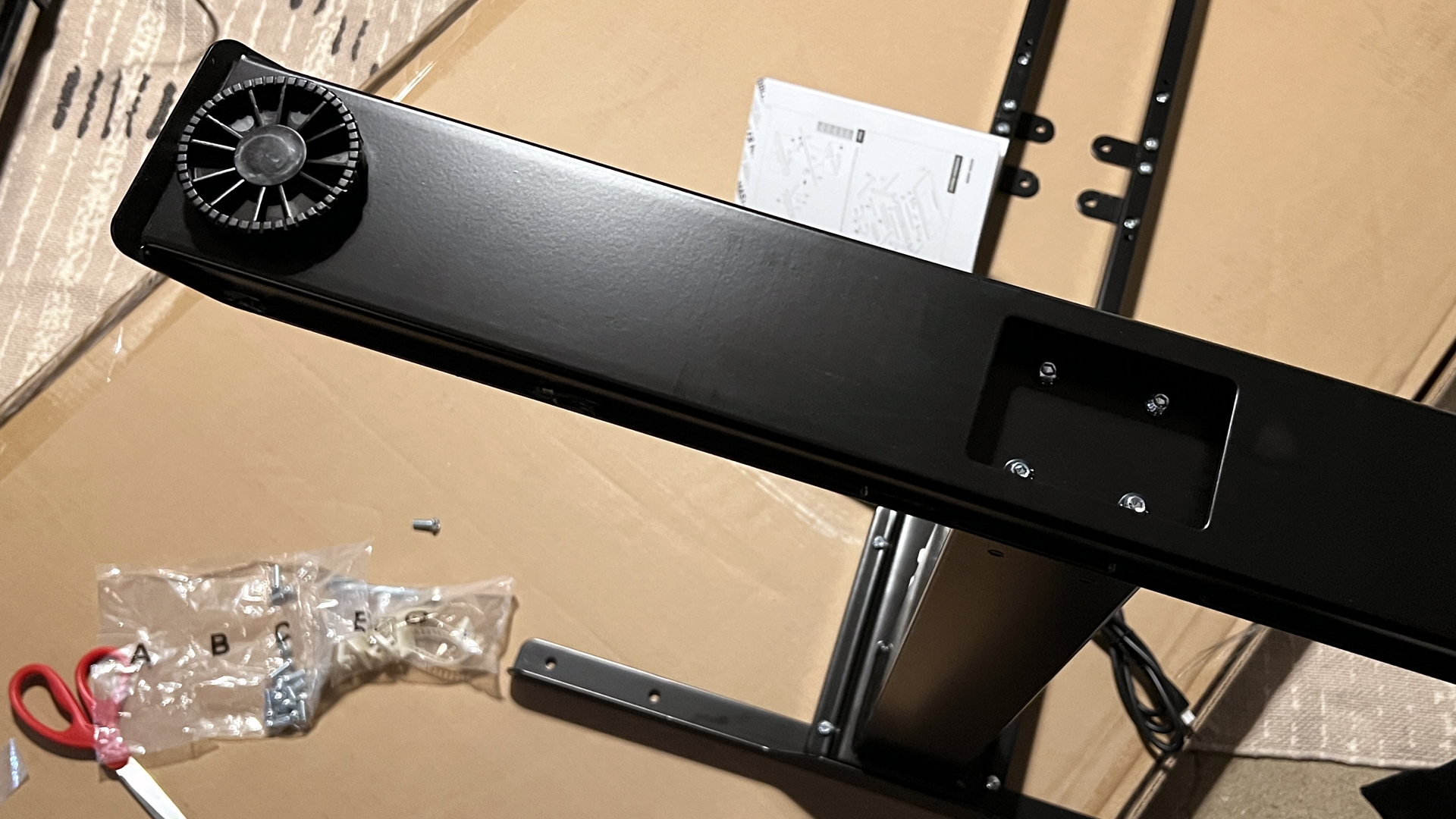
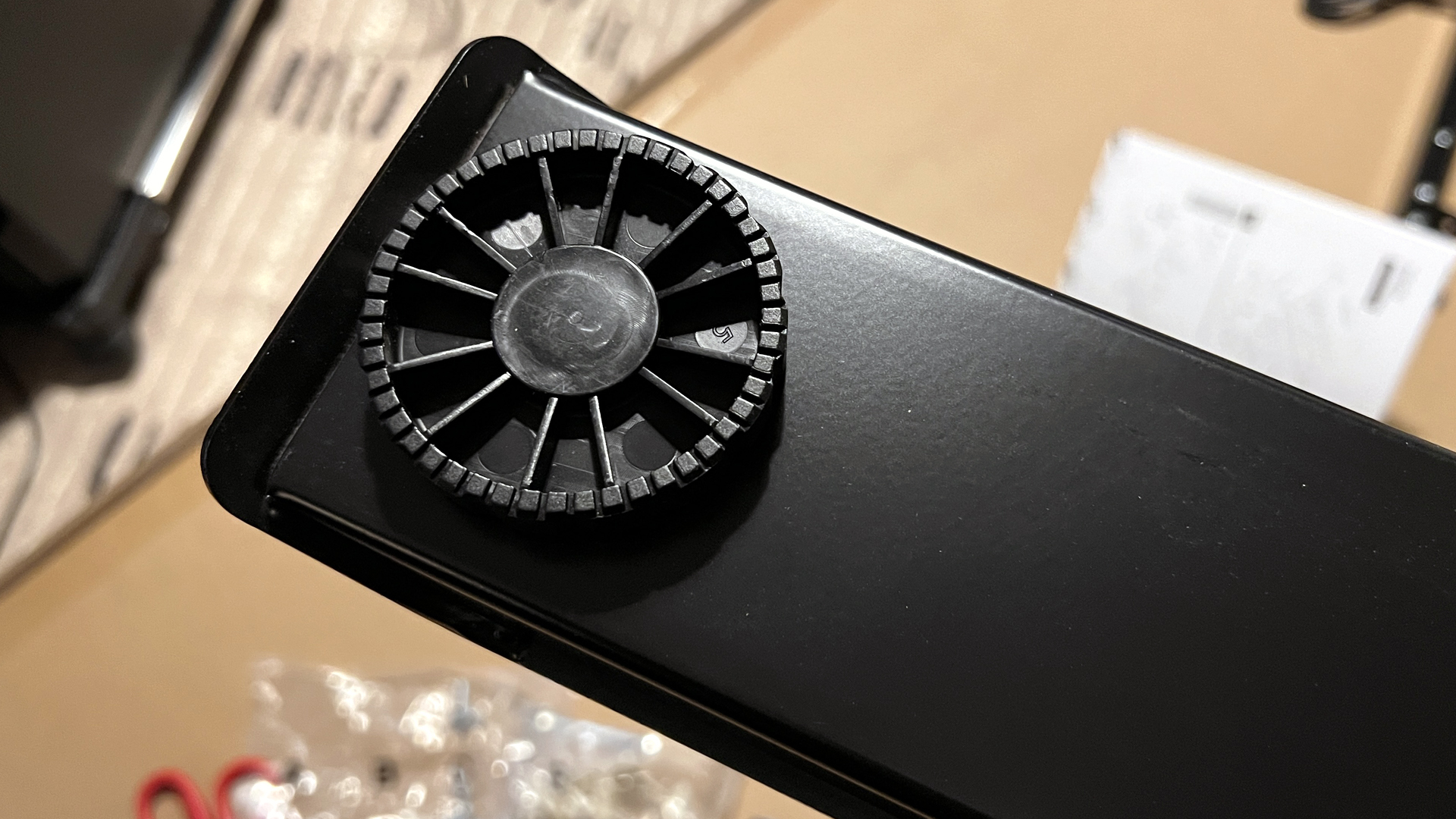
The GD160 ARGB is sturdy, but it’s not the strongest or sturdiest electric height-adjustable desk on the market. It has a maximum load capacity of 220.5 pounds (100kg), which isn’t exceptionally high but should be fine for a gaming setup. The desk has a steel frame and sits on two t-shaped legs with large, stable feet that measure 27 inches long by 3.5 inches wide (69 x 9 cm) and have built-in levelers. The frame doesn’t have a wedge system or traditional cross-support, and it does start to wobble a little as you raise the height. The desk still felt very sturdy to me at standing height (around 42 inches), with four mounted monitors (three 27-inch, one 24-inch) — I could shake it if I tried, but gaming normally didn’t induce any tremors.
The desk comes with a “smart” controller, which controls both the desk’s height and ARGB lighting, and can be mounted on either the right or left side of the tabletop (based on preference). The controller has a small screen and seven buttons: Up, down, 1, 2, 3, M, and A. The up and down buttons control the desk’s height — the desk moves smoothly, quickly, and quietly, and the controller’s screen displays the desk’s height (in cm).
Once you find a position you like, you can save it for the future. To save a position, press the ‘M’ button (the screen will display ‘S-’) and then press the button you want to program (1, 2, or 3). That’s all you have to do — once saved, tapping the programmed button will cause the desk to automatically move to the save position. (You can reprogram buttons with the same steps.)
The GD160 ARGB moves pretty quickly, so you’ll want to be careful — especially if your PC isn’t sitting on your desk. While the desk does have built-in collision detection, this relies on the tabletop directly colliding with an object — it won’t activate if something sitting on the tabletop hits something, nor will it prevent cables or cords from being ripped out. You can adjust the sensitivity of the desk’s built-in collision detection (or turn it off completely) by pressing and holding both arrow buttons for five seconds (each press cycles through sensitivity levels, from 3 - highest to 0 - off).
The controller also has a fast-charging USB-A port on its right side, which is extremely convenient for charging devices you’d normally keep within arm’s reach, such as your phone.
Features and Software of the GD160 ARGB
The GD160 ARGB is fully functional without software — you definitely do not need to plug the desk into your PC unless you really, really want to. You can control the desk’s ARGB lighting strips using the ‘A’ button on the controller. Tapping this button cycles through the desk's seven lighting configurations — five presets, one custom configuration that must be set up in MasterPlus+, and off. You can also turn the lighting off without cycling through the different presets by tapping and holding the ‘A’ button for three seconds (tap and hold for another three seconds to turn the lighting back on; the desk will remember the most recent lighting effect).
The desk comes with five preset lighting configurations: Spectrum, reload, recoil, breathing, and refill. Aside from “spectrum,” which features a continuous, flowing rainbow of color, all of the preset configurations are single-color and are set to Cooler Master purple by default. You can’t really change the lighting presets, but you can configure them to a limited degree (e.g. changing color, brightness, or speed) with MasterPlus+. You can also set up the sixth “custom” lighting preset in MasterPlus+ — this can only be set up as a static lighting configuration, but you can program each of the desk’s 192 lighting zones individually (if you want).
I feel like it’s important to mention, before I go any further, that MasterPlus+ isn’t exactly the most intuitive software. In fact, MasterPlus+ is very clunky and confusing, difficult to navigate, and ultimately pretty limited in what it can actually do. It’s also not exactly...refined — for example, when you’re programming the sixth custom lighting preset, the on-screen model is backward — the front of the desk on-screen actually corresponds with the back of the desk, and vice-versa. It’s very simple to work around once you realize what’s happening — but yeah.
The one good thing about this whole thing is that configuring the desk’s lighting presets in the GD160 ARGB tab in MasterPlus+ saves any changes to the desk’s onboard memory. That means you can use MasterPlus+ to program the lighting however you like, and then unplug the desk from your PC and control everything with the controller (which will now cycle through your newly-configured presets).
If you keep the desk plugged into your PC, you can do more — though I’m not sure it’s worth it. MasterPlus+ also has a main tab (default: Cooler Master System), which is where you can go if you want to do things like sync the desk’s lighting with other Cooler Master peripherals/components (if you have any), and/or with apps, programs, or games. While this does open up more lighting effects and immersive customization options, the preset/preloaded lighting patterns and tools in this section were obviously not designed with a desk in mind. The option is there if you want to try it, but it’s a frustrating experience (to say the least).
One feature the MasterPlus+ software does not include is the option to have the desk’s ARGB lighting shut down with your PC. This seems like it should definitely be an option, since the only other way to turn off the desk’s lighting is to press and hold the A button for three seconds (three seconds too long, in my opinion).
Bottom Line
The Cooler Master GD160 ARGB gaming desk is a sturdy, well-built, highly-adjustable gaming desk with bright, immersive ARGB lighting — perfect for anyone looking for a desk with built-in ambiance. This desk’s ARGB might seem a little gimmicky and over-the-top, but prior to trying this desk, I was actually using RGB strip lights along the back of my desk, because I find it to be the perfect amount of not-too-intense ambient lighting. I don’t necessarily find it more immersive, but I also don’t need that kind of immersion (which is good, because MasterPlus+ is too difficult to navigate for a slightly more immersive gaming experience).
The GD160 ARGB is a pretty impressive electric height-adjustable gaming desk even without the ARGB lighting — it has a relatively wide height range as well as built-in collision detection, an easy-to-use smart remote with a fast-charging USB port, and an easy-to-clean, scratch resistant finish. It’s not perfect — more robust cable management would definitely be appreciated, and while it’s sturdy enough for a gaming setup, you can definitely find stronger, steadier, and more powerful electric standing desks on the market — some for quite a bit cheaper. The GD160 ARGB is a great desk even without its flashy lighting, but the ARGB definitely makes up a chunk of that $899 price tag.

Sarah Jacobsson Purewal is a senior editor at Tom's Hardware covering peripherals, software, and custom builds. You can find more of her work in PCWorld, Macworld, TechHive, CNET, Gizmodo, Tom's Guide, PC Gamer, Men's Health, Men's Fitness, SHAPE, Cosmopolitan, and just about everywhere else.
-
Friesiansam Reply
Bright ARGB lightstrips are why I will never consider this desk.Admin said:But its premium price tag is probably only worth it if you’re wooed by the desk’s bright ARGB lightstrips. -
anthonyhawaii I'm pretty sure the amazon link provided in this article is for the wrong product.Reply

